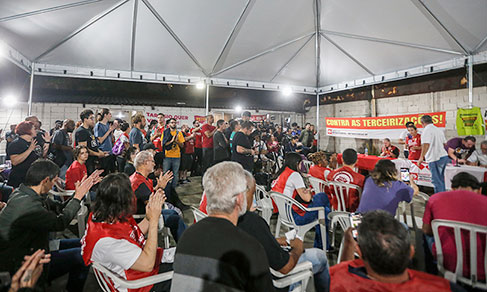2022 Census
2022 Census: one out of five Brazilians lives in rented household
December 12, 2024 10h00 AM | Last Updated: December 13, 2024 03h44 PM
Highlights
- In 2022, 72.7% of the Brazilian population lived in households owned by a resident (already paid, inherited, gained or still paying), 20.8%, in rented households, 5.6%, in granted or lent households (by employers, relatives or other form) and 0.8%, in other conditions of occupation.
- In 2000, these proportions were 76.8%, 12.3%, 9.7% and 1.2% and, in 2010, 75.2%, 16.4%, 7.7% and 0.7%, respectively.
- In 2022, the proportion of residents in households owned by a resident (already paid, inherited, gained or paying) exceeded 50% in 5,553 municipalities.
- In 2022, 87.0% of the Brazilian population lived in housing units with outside walls of masonry with coating or stucco with coating. The second more common option was masonry without coating, with 7.6%, followed by construction wood, with 4.1%. In 2010, these proportions were 79.0%, 11.6% and 6.9%, respectively.
- In 2022, 0.2% of the population living in permanent private households lived in housing units with only one room, whereas 1.5% lived in housing units with two rooms.
- Housing units with three rooms comprised 5.3% of the population, those with four rooms, 13.5% and those with five rooms, 29.2%. Housing units comprising six to nine rooms housed 44.4% of the population, whereas the remaining 5.9% of the population lived in housing units with ten or more rooms.
- The proportion of residents with a washing machine at home was 68.1% in 2022. In 2010, this proportion was 46.9% and, in 2000, 31.8%. According to the color or race, 41.8% of the brown population did not have any washing machine at home. The proportion was 41.3% for black persons, 18.9% for white persons and 10.8% for yellow persons. For indigenous persons, the parcel was 74.0%.
- In 2022, 89.4% of the Brazilian population lived in households with access to the Internet. According to color or race, 12.9% of the black population did not have home access to the Internet, 12.7% of the brown population, 7.5% of the white population and 5.6% of the yellow population. For indigenous persons, the parcel was 44.5%.

In 2022, the proportion of Brazilians who lived in rented households maintained the upward trend and reached 20.9% of the population. In 2000, this parcel was 12.3% and, in 2010, 16.4%. Even so, own households significantly prevail, with 72.7% of the Brazilian population living in households owned by one of the residents (already paid, inherited, gained or still paying). On the other hand, 5.6% of the population lived in households granted or lent (by employers, relatives or other form) and 0.8%, in other conditions of occupation.
In 2000, these proportions were 76.8% for own households, 9.7% for those granted and 1.2% in other conditions and, in 2010, 75.2%, 7.7% and 0.7%, respectively. The data are from "2022 Population Census: Characteristics of households - Sample preliminary results," released today (12) by the IBGE.
The release event is scheduled for 10 am at the Jones dos Santos Neves Institute, in Vitória (ES). The Digital IBGE will broadcast live. The data are also available on Sidra and on the Census Overview.
"This is the first release based on the sample questionnaire of the 2022 Population Census, which is an extended questionnaire applied to nearly 10% of the Brazilian population. This information is preliminary for now, since the IBGE still did not delimit the weighting areas, whose process is underway and requires assuring with the city administrations that the areas match the planning of public policies," explains Bruno Mandelli, an analyst of the IBGE´s Coordination of Social Indicators.

94.6% of the population lives in housing units with outside walls of masonry (with or without coating) or of stucco with coating
Concerning the structural elements of the housing units, the 2022 Population Census investigated the material that prevails in the outside walls. A proportion of 87.0% of the Brazilian population lived in housing units with outside walls of masonry with coating or stucco with coating. The second most common material was masonry without coating (7.6%).
Construction wood prevailed in housing units of 4.1% of the population, followed stucco without coating (0.6%), whereas 0.1% of the population lived in housing units with wooden walls from sidings, packages or scaffolds. Material not covered by the previous categories comprise the walls of 0.5% of the population in 2022.
It should also be highlighted that nearly 7 thousand persons, equivalent to 0.004% of the population, lived in housing units without walls. "As a Census concept, housing units should have walls. However, indigenous localities are an exception, since houses are only covered in some Brazilian indigenous ethnicities. In these cases, the IBGE includes housing units without walls," highlights Mandelli.
Between 1970 and 2022, proportion of housing units with up to three rooms falls 20 percentage points
The analysis of the housing unit’s data throughout the last five Censuses shows that the proportion of housing units with up to three rooms dropped consistently, changing from 29.1% in 1970 to 9.0% in 2022. According to the IBGE, rooms are all the spaces covered by a ceiling and limited by walls (vertical construction that allows to limit, divide or close spaces off) that integrate a housing unit, including bathrooms and kitchens. Halls, porches and garages are not considered rooms.
"Housing units with up to three rooms were significantly reduced, whereas housing units with four rooms reduced not so significantly. The proportion of housing units with five rooms increased, whereas those with six or more grew up to 2000 and then became stable, which can be related to the fact that the number of residents per housing unit has reduced, possibly causing a lower demand for housing units with more rooms," points out the analyst.

In 2022, 0.2% of the population lived in housing units with only one room, whereas 1.5% lived in housing units with two rooms. Housing units with three rooms comprised 5.3% of the population, those with four rooms, 13.5% and those with five rooms, 29.2%. Housing units comprising six to nine rooms housed 44.4% of the population, whereas the remaining 5.9% of the population lived in housing units with ten or more rooms.
Proportion of households with more than three persons per bedroom falls to 2.6%
In 2022, 2.6% of the Brazilian permanent private households had more than three residents per bedroom, which means that at least four persons slept in the same environment. In 2000, this proportion was 9.6% and, in 2010, 5.6%.
Another 8.4% of the households had more than two residents up to three residents per bedroom. Households with more than one resident up to two residents per bedroom represented 53.9% of the total, and the households with only one resident per bedroom reached 35.1%.
Concerning color or race, the proportion of residents in permanent private households with two or more residents per bedroom was 22.3% for the brown population, 20.6% for the black population, 12.6% for the white population and 6.8% for the yellow population. For indigenous persons, this proportion was 53.6% of the total, though it should be analyzed taking into account their cultural specificities.
In 2022, 68.1% of the population had a washing machine at home
Between 2000 and 2022, the proportion of the population that lived in households with a washing machine more than doubled, changing from 31.8% to 68.1%.
All the Major Regions grew. The Northeast Region registered the lowest proportion of washing machines in 2022, with 37.1%, whereas the highest proportion was recorded in the South Region (89.8%). The Central-West Region stood out, as it expanded 52.5 percentage points, the biggest expansion among the Major Regions, rising from 26.7% to 79.2%.

Santa Catarina leads among the Federation Units, with 94.2% of the population in households with a washing machine. On the other hand, Maranhão reported the lowest rate (27.0%). "It should be noted that, in 2022, Maranhão had a proportion of washing machines lower than the national average reported 22 years ago, in 2000 (31.8%)," explains Bruno Perez, an analyst of the survey.
"The presence of washing machines in the households might have a significant impact on the daily life of residents, especially women, who wash clothes most of time," states Perez.
Among the municipalities with more than 100 thousand inhabitants, São Caetano do Sul (SP) registered the highest proportion (97.6%) of households with a washing machine. In this set of municipalities, the lowest proportion was recorded in Codó (MA) (17.8%).
"It is noticed that the proportion of presence of washing machines exceeded 95% of the population in 212 municipalities in 2022, being 206 of them in the South Region. In other 160 municipalities, less than 10% of the population lived in households with a washing machine. Of them, 152 were located in the Northeast Region," completes the analyst.
Concerning color or race, the proportion of persons that did not have a washing machine at home was 10.8% for yellow persons, 18.9% for white persons, 41.3% for black persons, 41.8% for brown persons and 53.6% for indigenous persons.
"We should have caution with the results of indigenous persons, as they only refer to those persons who self-declared of indigenous color or race, thus not corresponding to the entire indigenous population, which also comprises persons included in the question "consider themselves indigenous." In addition, housing conditions of indigenous peoples can only be properly examined in the light of their cultural specificities," highlights Perez.
Concerning the age groups, 37.2% of the persons aged between 0 and 4 years did not have a washing machine at home, whereas 29.8% of those aged 70 years and over did not have such domestic appliance at home.
In 2022, 89.4% of the Brazilian population had Internet at home
The 2022 Population Census registered for the first time ever the number of persons with access to the Internet in Brazil. In this case, 89.4% of the Brazilian population lived in households with access to the Internet. Among the Federation Units, the Federal District recorded the highest proportion, with 96.2% of the population. On the other hand, Acre had the lowest one (75.2%).
No municipality reported 100% of the population living in households with access to the Internet. Nevertheless, the proportion of home access to the Internet exceeded 95% of the population in 179 municipalities, being 98 of them in the South Region. Among the ten municipalities with the highest percentages of home access to the Internet, eight of them were located in Santa Catarina. In contrast, 33 municipalities registered less than half of the population with home access to the Internet, among which 32 were located in the North Region.
Among the indigenous persons, 44.5% do not have access to the Internet at home
Considering the disaggregation by color or race, the highest proportion of the population without access to the Internet was recorded among the indigenous persons (44.5%). Among the black persons, 12.9% did not have access and, for the brown persons, the percentage was 12.7%. Among the white persons, 7.5% did not have access and, for the population of yellow color or race, 5.6% lived in households without Internet.
In terms of age, the highest proportion of access to the Internet at home was reached in the ranges between 25 and 29 years, 30 and 34 years, and 35 and 39 years, all of them with 92% of the population living in households with access to the Internet. The lowest value was registered in the group aged 70 years and over (72.4%).
More about the survey
With this publication, the IBGE begins to release data raised by the sample questionnaire of the 2022 Population Census. The block of characteristics of households/housing units of the sample questionnaire essentially investigated six elements: occupation condition of the household (whether own. rented or granted), material of the outside walls, number of rooms, number of bedrooms, existence of washing machine and existence of home access to the Internet.



















